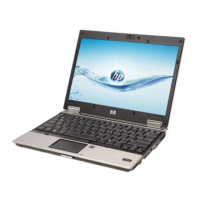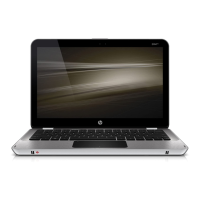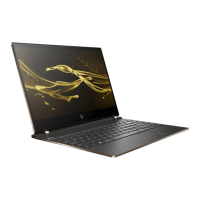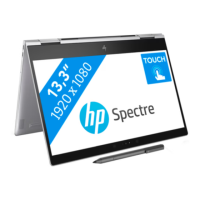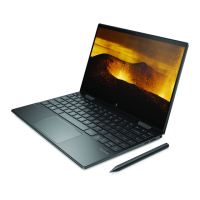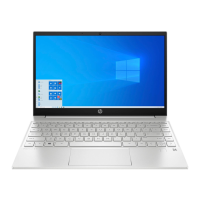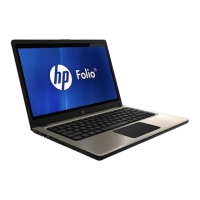Do you have a question about the HP 13-C110NR and is the answer not in the manual?
| Brand | HP |
|---|---|
| Model | 13-C110NR |
| Processor | Intel Celeron N3060 |
| Processor Speed | 1.6 GHz |
| RAM | 4 GB |
| Storage | 32 GB eMMC |
| Display Size | 13.3 inches |
| Resolution | 1366 x 768 |
| Operating System | Chrome OS |
| Battery Life | Up to 11 hours |
| Color | Silver |
| Graphics | Intel HD Graphics |
Access the HP Apps Store for games, music, and productivity applications.
Recommended steps after setup for optimal computer use and investment.
Instructions to identify installed hardware components using Device Manager.
Steps to find installed software programs via Start menu or Programs and Features.
Identifies and describes components located on the right side of the computer.
Identifies and describes components located on the left side of the computer.
Identifies and describes display-related components like webcam and microphones.
Explains the TouchPad zone and buttons for navigation and interaction.
Describes the function of various indicator lights such as power, caps lock, and mute.
Details the operation of the power button for turning on, sleep, and hibernation.
Identifies key components and explains the function of action keys for system functions.
Explains the location and information found on service and regulatory labels on the computer.
Guides on connecting to wireless networks like WLAN and HP Mobile Broadband.
Explains how to control wireless devices using airplane mode key and OS controls.
Steps to establish a connection to a Wireless Local Area Network (WLAN).
Information on using HP Mobile Broadband for internet connectivity.
Details on accessing Mobile Broadband via HP DataPass without contracts.
Information on using the Global Positioning System (GPS) device for location services.
Guide on connecting and using Bluetooth devices for short-range wireless communication.
Instructions for establishing a wired LAN connection to a router or network.
Explains how computers on a network can exchange software and data.
How to use the integrated webcam or 3D camera for video and photos.
Information on playing music, streaming audio, and recording audio.
How to connect wired or wireless speakers to the computer.
Steps for connecting wired headphones to audio jacks.
How to connect a microphone for audio recording.
Guide for connecting wired headsets to audio combo jacks.
Adjusting system volume, sounds, and managing audio devices via settings.
Using the computer for streaming and downloading video content.
How to connect external displays or TVs using an HDMI cable.
Configuring audio output for HDMI-connected devices.
Connecting to wireless displays using Miracast technology.
Connecting to wireless displays using Intel WiDi technology.
Explains how to use touch gestures on the TouchPad and touch screen for navigation.
How to tap and double-tap to select or open items on the screen.
How to zoom in or out on images and text using two fingers.
How to scroll pages or images using two fingers on the TouchPad.
How to use a two-finger tap on the TouchPad to open context menus.
How to pan or scroll by sliding one finger on a touch screen.
Using keyboard and mouse for navigation and performing functions.
Explains Sleep and Hibernation power-saving states for the computer.
Steps to manually put the computer into and wake from Sleep mode.
Steps to manually initiate and exit Hibernation mode on supported products.
How to set a password requirement when waking the computer from Sleep or Hibernation.
Using the power meter icon and Power Options for managing power.
How the computer operates on battery power and battery life factors.
How to check the battery status using HP Battery Check.
How to access battery information and specifications via HP Support Assistant.
Tips and methods to conserve battery power and maximize battery life.
How to identify low or critical battery levels through indicators and notifications.
Steps to resolve low battery levels with external power or when unable to exit Hibernation.
How the computer operates when connected to AC power.
How to troubleshoot issues related to the AC adapter and power connection.
Recommended procedures for safely shutting down the computer.
How to improve computer performance through regular maintenance tasks.
Steps to run Disk Defragmenter to optimize the hard drive.
Steps to use Disk Cleanup to free up disk space by deleting unnecessary files.
How HP 3D DriveGuard protects the hard drive during physical shocks.
How to check the status of HP 3D DriveGuard for hard drive protection.
How to update software programs and drivers for optimal performance and features.
Recommended products and precautions for safely cleaning the computer.
Procedures for safely cleaning the computer's display, sides, and keyboard.
Tips for safely preparing the computer for travel or shipping.
Guidelines and tips for creating and managing computer passwords.
Setting up user and administrator passwords for Windows accounts.
How to set administrator and power-on passwords in the BIOS Setup Utility.
How to set up and use the fingerprint reader for secure login.
Importance of internet security software like antivirus and firewalls for protection.
Details on using antivirus software to detect and remove viruses.
Information on firewalls to prevent unauthorized network access.
Importance of installing regular software updates for security and performance.
Using HP Touchpoint Manager for device management and security.
Enabling security features to protect wireless networks from unauthorized access.
Regularly backing up data to protect against loss from failures or attacks.
How to use an optional security cable to deter theft.
Steps to access the BIOS Setup Utility on different computer types.
Information on obtaining and updating BIOS versions from the HP website.
How to find the current BIOS version using HP Support Assistant.
Detailed steps to download and install a BIOS update from HP.
How to synchronize firmware between a tablet and its keyboard.
Steps to launch the HP PC Hardware Diagnostics tool.
How to download the diagnostic tool to a USB drive.
Methods for creating recovery media and system backups.
Steps to create HP Recovery media using HP Recovery Manager.
Using Windows tools for system restore points and personal information backups.
Overview of options for restoring and recovering the computer system.
How to use HP Recovery Manager for system recovery.
Important information and prerequisites before starting recovery procedures.
How to perform system recovery using the HP Recovery partition.
Steps to recover the system using HP Recovery media.
How to change the computer's boot order for recovery media.
Steps to remove the HP Recovery partition to free up hard drive space.
Details on input power requirements and ratings for the computer.
Specifications for the computer's operating and non-operating environment.
Precautions to prevent damage from electrostatic discharge during handling.
Information on operating system assistive technologies supported by HP products.
Contact information for customer support regarding accessibility and technical issues.

